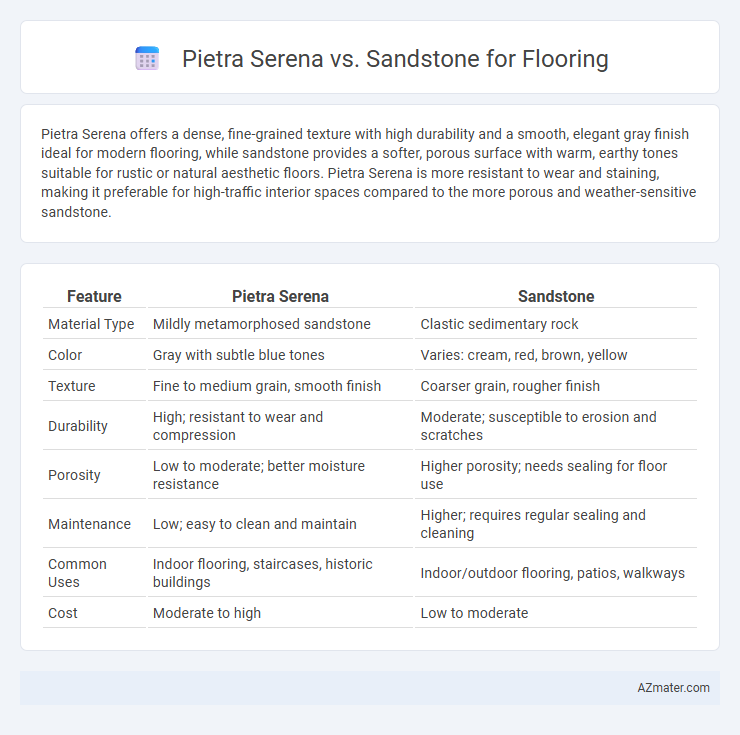Pietra Serena offers a dense, fine-grained texture with high durability and a smooth, elegant gray finish ideal for modern flooring, while sandstone provides a softer, porous surface with warm, earthy tones suitable for rustic or natural aesthetic floors. Pietra Serena is more resistant to wear and staining, making it preferable for high-traffic interior spaces compared to the more porous and weather-sensitive sandstone.
Table of Comparison
| Feature | Pietra Serena | Sandstone |
|---|---|---|
| Material Type | Mildly metamorphosed sandstone | Clastic sedimentary rock |
| Color | Gray with subtle blue tones | Varies: cream, red, brown, yellow |
| Texture | Fine to medium grain, smooth finish | Coarser grain, rougher finish |
| Durability | High; resistant to wear and compression | Moderate; susceptible to erosion and scratches |
| Porosity | Low to moderate; better moisture resistance | Higher porosity; needs sealing for floor use |
| Maintenance | Low; easy to clean and maintain | Higher; requires regular sealing and cleaning |
| Common Uses | Indoor flooring, staircases, historic buildings | Indoor/outdoor flooring, patios, walkways |
| Cost | Moderate to high | Low to moderate |
Introduction to Pietra Serena and Sandstone Flooring
Pietra Serena is a dense, fine-grained gray sandstone renowned for its durability and elegant matte finish, making it a popular choice for sophisticated flooring applications. Sandstone flooring, characterized by its natural texture and warm earth tones, offers versatility and slip resistance, ideal for both indoor and outdoor use. Both materials provide unique aesthetic appeal, with Pietra Serena delivering a refined, uniform look, while sandstone showcases varied patterns and colors influenced by its mineral composition.
Geological Origins and Composition
Pietra Serena, a dense, fine-grained sandstone primarily composed of quartz and feldspar, originates from the volcanic regions of Tuscany, Italy, making it a durable and elegant choice for flooring. In contrast, sandstone varies widely in composition, often including quartz, feldspar, and mica, formed from compacted sand particles deposited in diverse sedimentary environments worldwide. The unique volcanic sediment mixture in Pietra Serena imparts a consistent gray-blue hue and enhanced strength compared to the more porous and variable texture of typical sandstone.
Aesthetic Differences: Color and Texture
Pietra Serena features a smooth, fine-grained texture with a classic gray-blue hue that imparts a sophisticated, elegant aesthetic to flooring, often sought in Tuscan-inspired interiors. Sandstone offers a wider color spectrum, ranging from warm earth tones like reds, yellows, and browns to softer beiges, with a coarser, more porous texture that creates a rustic, natural appearance. The uniformity of Pietra Serena contrasts with the varied, organic patterns of sandstone, making each material distinct in visual impact and architectural style.
Durability and Wear Resistance
Pietra Serena, a dense and fine-grained sandstone, offers higher durability and wear resistance compared to typical sandstone varieties, making it an excellent choice for high-traffic flooring applications. Its natural hardness and resistance to abrasion ensure that floors maintain their appearance and structural integrity over time, even under heavy use. In contrast, standard sandstone tends to be softer and more porous, making it more susceptible to scratches, erosion, and wear in demanding environments.
Slip Resistance and Safety Considerations
Pietra Serena, an Italian sandstone, offers moderate slip resistance due to its fine-grained texture, making it suitable for indoor flooring where safety is a concern. Traditional sandstone varies widely in slip resistance depending on its porosity and finish, often requiring sealants or treatments to enhance safety on wet surfaces. Both materials benefit from anti-slip coatings or textured finishes to prevent slips, but Pietra Serena's uniform surface typically provides more predictable traction in residential and commercial settings.
Maintenance and Cleaning Requirements
Pietra Serena, a dense Tuscan sandstone, requires regular sweeping and occasional damp mopping with a pH-neutral cleaner to maintain its smooth, matte finish while preventing staining and etching. Sandstone floors, being more porous and softer, demand more frequent sealing and gentle cleaning with non-abrasive, pH-neutral cleaners to avoid surface damage and discoloration. Both materials benefit from prompt spill cleanup, but sandstone generally needs more vigilant upkeep to preserve its appearance and structural integrity.
Environmental Impact and Sustainability
Pietra Serena, a dense, fine-grained sandstone primarily quarried in Tuscany, offers a relatively low environmental impact due to its local sourcing and durability, minimizing transportation emissions and replacement frequency. Sandstone varieties, widely available globally, vary in sustainability depending on quarrying practices and transportation distances, with some operations causing significant habitat disruption and higher carbon footprints. Choosing Pietra Serena supports sustainable flooring by reducing environmental degradation and promoting resource efficiency through its longevity and regional extraction.
Cost Comparison and Value
Pietra Serena is a premium Italian sandstone known for its elegant gray-blue hue and durability, often commanding higher prices due to its rarity and aesthetic appeal. In contrast, generic sandstone options tend to be more affordable but may vary significantly in quality and longevity, affecting overall value. Choosing Pietra Serena for flooring offers a long-term investment with enhanced resale value and timeless design, while standard sandstone provides budget-friendly versatility with potentially higher maintenance costs.
Popular Applications in Interior Design
Pietra Serena is favored for contemporary interior flooring due to its smooth texture and cool gray tones, enhancing modern living spaces and minimalist aesthetics. Sandstone, with its natural earthy hues and textured surface, is popular in rustic, Mediterranean, and bohemian interior designs, providing warmth and a tactile appeal. Both materials are durable, but Pietra Serena is often selected for sleek urban interiors, while sandstone suits casual, nature-inspired environments.
Choosing Between Pietra Serena and Sandstone: Key Factors
When choosing between Pietra Serena and sandstone for flooring, consider durability and aesthetic appeal as key factors. Pietra Serena, a dense Tuscan sandstone, offers a smooth, elegant blue-grey finish ideal for modern interiors, while sandstone varies widely in color and texture, providing more rustic, earthy tones. Assess moisture resistance and maintenance requirements, as Pietra Serena generally resists moisture better, making it suitable for high-traffic, indoor areas, whereas sandstone may need sealing and more upkeep.

Infographic: Pietra Serena vs Sandstone for Floor
 azmater.com
azmater.com